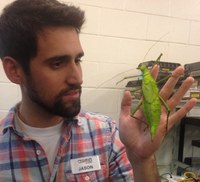For the Love of the Bugs
Jason Schaller has been collecting arthropods—more colloquially known as “bugs”—since he was kid.
He still remembers his first encounter with a giant silk moth as a 3-year-old. He says he was astounded by the size, elegant beauty and colorful “eyes” patterned on the wings of what he would later identify as a Polyphemus moth.
“I was amazed that these other-worldly creatures were flying around New Jersey (and almost every other state) while most people aren’t even aware of their existence,” Schaller said.
This experience, bolstered by the influence of a naturalist father and grandfather, planted the seed for a lifelong fascination with insects and arachnids. Today, he focuses his passion as the ABQ BioPark Botanic Garden's BUGarium curator.
Schaller has been at the ABQ BioPark since August 2016 and says he hopes to both maintain and grow the exhibit, which he calls one of the best in the nation.
“As an entomologist, I still can’t believe it exists,” he said.
There is no typical day at the BUGarium, says Schaller. The facility has more than 1,000 arthropod residents, representing nearly 100 different species, at any given time—residents that he and his staff of five is responsible for keeping alive and healthy.
Arthropods, including insects, arachnids, centipedes, millipedes and crustaceans, account for more species and more species diversity than any other group of animals on Earth. BUGarium visitors get a unique view of about 68 arthropod species, from the flashy greenbottle blue tarantula to thousands of diligent, marching leafcutter ants. The staff also cares for and assists in the reproduction of about 40 additional species behind the scenes at the Arthropod Rearing Lab.
As you walk into the lab, you’ll notice that it’s markedly more humid than New Mexico’s typically arid air. That’s because many of the species, especially the tropical ones, favor moister environments.
Care varies a lot from species to species. Food wise, there are two main groups, though—meat eaters and leaf eaters. Stick insects like the green jungle nymph get a lot of fresh foliage to munch on while carnivores like tarantulas snack on crickets.
Besides keeping the animals alive, one of the main goals of the lab is to rear new generations. After females lay their eggs, staff assists to ensure that the new generation makes it. Protocol varies per species. For instance, millipedes lay eggs in the soil and a highly hands-off approach of misting and observing works. Mantids are a bit more hands-on—young are separated shortly after hatching, as the species can turn cannibalistic.
More than three quarters of Earth’s animal species are arthropods. Schaller says that although these “bugs” are often maligned, they are actually some of the most beautiful and fascinating creatures in the world.
“Looking at the smaller organisms on our planet is sort of like a gateway drug to realizing and appreciating the awesome beauty and complexity of our universe,” he said. “This place is here to open the public’s eyes and minds. The animals in this building hold more incredible stories than anyone could imagine.”
He also says that without arthropods—the spiders, the cockroaches, the ants—life as we know it would cease to exist because they help pollinate our food, are important food sources for birds and mammals and help recycle our waste.
“Arthropods are essential to all life on earth,” Schaller said. “The food web would collapse without them.”

